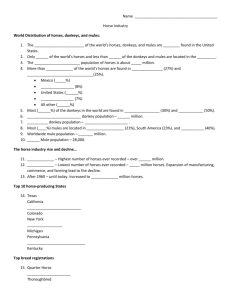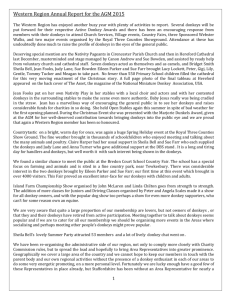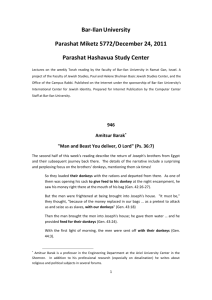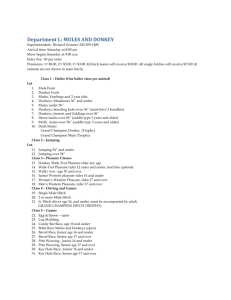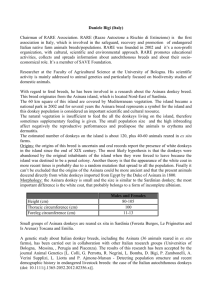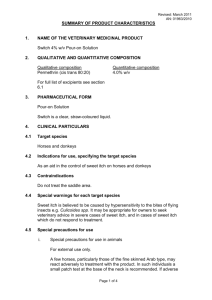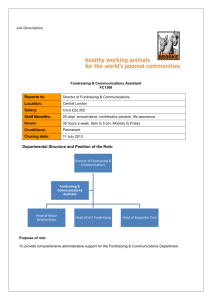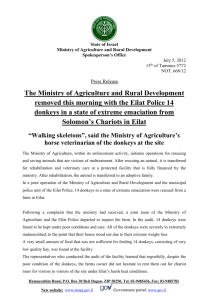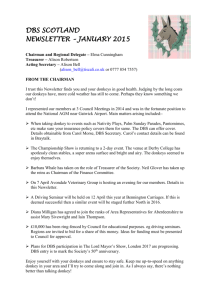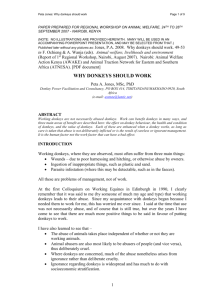Equine number and welfare within ATNESA countries
advertisement
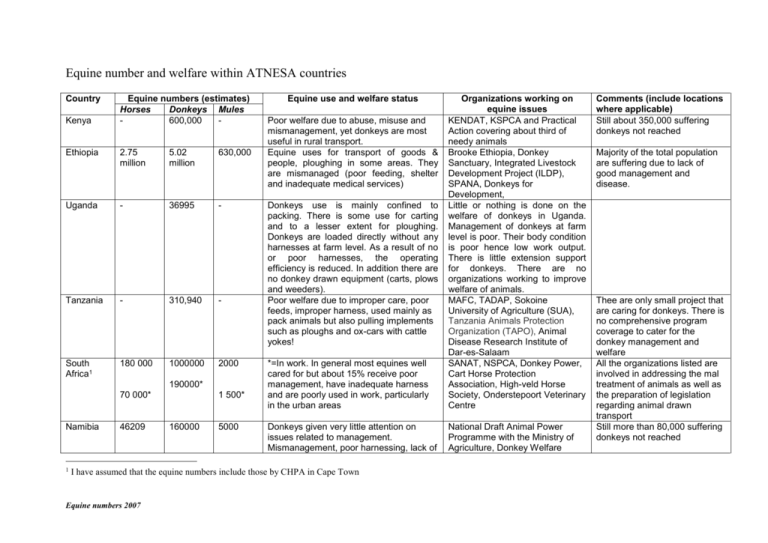
Equine number and welfare within ATNESA countries Country Kenya Equine numbers (estimates) Horses Donkeys Mules 600,000 - Ethiopia 2.75 million 5.02 million 630,000 Uganda - 36995 - Tanzania - 310,940 - South Africa1 180 000 1000000 2000 190000* 70 000* Namibia 1 46209 1 500* 160000 5000 Equine use and welfare status *=In work. In general most equines well cared for but about 15% receive poor management, have inadequate harness and are poorly used in work, particularly in the urban areas Organizations working on equine issues KENDAT, KSPCA and Practical Action covering about third of needy animals Brooke Ethiopia, Donkey Sanctuary, Integrated Livestock Development Project (ILDP), SPANA, Donkeys for Development, Little or nothing is done on the welfare of donkeys in Uganda. Management of donkeys at farm level is poor. Their body condition is poor hence low work output. There is little extension support for donkeys. There are no organizations working to improve welfare of animals. MAFC, TADAP, Sokoine University of Agriculture (SUA), Tanzania Animals Protection Organization (TAPO), Animal Disease Research Institute of Dar-es-Salaam SANAT, NSPCA, Donkey Power, Cart Horse Protection Association, High-veld Horse Society, Onderstepoort Veterinary Centre Donkeys given very little attention on issues related to management. Mismanagement, poor harnessing, lack of National Draft Animal Power Programme with the Ministry of Agriculture, Donkey Welfare Poor welfare due to abuse, misuse and mismanagement, yet donkeys are most useful in rural transport. Equine uses for transport of goods & people, ploughing in some areas. They are mismanaged (poor feeding, shelter and inadequate medical services) Donkeys use is mainly confined to packing. There is some use for carting and to a lesser extent for ploughing. Donkeys are loaded directly without any harnesses at farm level. As a result of no or poor harnesses, the operating efficiency is reduced. In addition there are no donkey drawn equipment (carts, plows and weeders). Poor welfare due to improper care, poor feeds, improper harness, used mainly as pack animals but also pulling implements such as ploughs and ox-cars with cattle yokes! I have assumed that the equine numbers include those by CHPA in Cape Town Equine numbers 2007 Comments (include locations where applicable) Still about 350,000 suffering donkeys not reached Majority of the total population are suffering due to lack of good management and disease. Thee are only small project that are caring for donkeys. There is no comprehensive program coverage to cater for the donkey management and welfare All the organizations listed are involved in addressing the mal treatment of animals as well as the preparation of legislation regarding animal drawn transport Still more than 80,000 suffering donkeys not reached Zimbabwe 18,000 400,000 Not known but negligible Malawi 1,000 3,000 - Swaziland 400 18,000 150 Lesotho 75,894 143,436 296 Equine numbers 2007 knowledge on basic health management and animal husbandry, yet donkeys are used mostly for rural transport and tillage operations. Donkeys widely used for draught particularly in semi-arid regions. Generally poor management and welfare although farmers are increasingly aware of their usefulness. Current research aims at improving donkey welfare. Horses and mules not commonly used. Horses are used for sports because they are very expensive for the farmers to purchase and use on the farm. Donkeys are used for carting mostly as the country has few equipment for use by donkeys. Farmers are now more interested to keep donkeys than oxen because of cattle theft Donkeys are not eaten in Malawi. Donkeys used for transport and draft power in rural communities. Mules used for draft power. Horses used for transport and sports. Poor welfare status of donkeys include poor harnessing, health care and nutrition. Problems with drought have left everyone and their animals short of food, even the animals earning income from tourism are thin, others with no income from their horses are even worse. Horses regularly even in a good year show large seasonal changes in live weight. Priority for cattle feeding is first. Uses of horses: Paying lobola Means of transport (riding mainly with some pack and carting) Racing Namibia, and Veterinary Directorate to some extend, very few Vets. Donkey Protection Trust, SPCA, APNEZ (currently defunct) 70 % of Zimbabwe’s donkeys are in the drier western regions and interventions should target these areas Ministry of Agriculture and Food security Departments of Animal Health and Industry and also the Department of Research Services. There is a big demand for donkeys in the country. University of Swaziland, dept. of Animal production and health, Dept of Mechanization and land use. Teaching and research; Ministry of Agr. Extension services ILPH have just started some courses for to help improve skills in farriery, saddlery in Lesotho and for owners in nutrition and management. The Vet Faculty at Onderstepoort also visit there from University of Pretoria The is no formal project addressing Donkey problems. The university is developing a proposal addressing training program for rural donkey farmers on donkey welfare Basotho Pony Project was engaged in both breeding and pony trekking. The project phased out and all the activities expect for the trekking are no more implemented. Even the number of horses has gone down, that individual farmers have been grouped to assist in trekking activities during time of need. Some organizations are considering ordering more from Tanzania and Mozambique to boost up the numbers. Trekking by tourists Donkeys and mules are mismanaged as compared to horse and are used for carrying extra heavy loads. Zambia < 500 Equine numbers 2007 < 5000 - Horses used for sports by wealthy individuals and for ceremonial events by Ministry of Home Affairs. Initially imported from Kenya, South Africa and Zimbabwe – currently knowledge is available for breeding locally. Donkeys are on the increase mainly through imports from Zimbabwe, Botswana, Mozambique, Namibia and Tanzania as an alternative to oxen as draught animals – however poor welfare is reported due to inadequate knowledge, lack of experience and appreciation. Ministry of Agriculture involved in training, extension as well as veterinary inputs for donkeys. Livestock Development Trust (LDT) train donkeys and periodically sells them for farm operations. World Vision International provides credit for donkey acquisition to smallholder farmers, whereas Kasisi Agricultural Training Centre also trains farmers on management and utilization of donkeys and provides credit. There are four lodges (MolimoNthuse, Malealea, Ramabanta and Semonkong) in the highland areas of Lesotho that have organized horse owners (form associations) that provide horses for trekking. They have been provided with training on management of horses. There is big demand for donkeys in areas prone to cattle diseases in the Southern and Central part of the country but steady supply is still a constraint.
